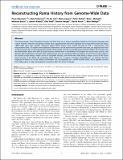| dc.contributor.author | Moorjani, Priya | |
| dc.contributor.author | Patterson, Nick | |
| dc.contributor.author | Loh, Po-Ru | |
| dc.contributor.author | Lipson, Mark | |
| dc.contributor.author | Kisfali, Péter | |
| dc.contributor.author | Melegh, Bela I. | |
| dc.contributor.author | Bonin, Michael | |
| dc.contributor.author | Kádaši, Ľudevít | |
| dc.contributor.author | Rieß, Olaf | |
| dc.contributor.author | Berger, Bonnie | |
| dc.contributor.author | Reich, David | |
| dc.contributor.author | Melegh, Béla | |
| dc.date.accessioned | 2013-07-09T19:19:57Z | |
| dc.date.available | 2013-07-09T19:19:57Z | |
| dc.date.issued | 2013-03 | |
| dc.date.submitted | 2012-11 | |
| dc.identifier.issn | 1932-6203 | |
| dc.identifier.uri | http://hdl.handle.net/1721.1/79422 | |
| dc.description.abstract | The Roma people, living throughout Europe and West Asia, are a diverse population linked by the Romani language and culture. Previous linguistic and genetic studies have suggested that the Roma migrated into Europe from South Asia about 1,000–1,500 years ago. Genetic inferences about Roma history have mostly focused on the Y chromosome and mitochondrial DNA. To explore what additional information can be learned from genome-wide data, we analyzed data from six Roma groups that we genotyped at hundreds of thousands of single nucleotide polymorphisms (SNPs). We estimate that the Roma harbor about 80% West Eurasian ancestry–derived from a combination of European and South Asian sources–and that the date of admixture of South Asian and European ancestry was about 850 years before present. We provide evidence for Eastern Europe being a major source of European ancestry, and North-west India being a major source of the South Asian ancestry in the Roma. By computing allele sharing as a measure of linkage disequilibrium, we estimate that the migration of Roma out of the Indian subcontinent was accompanied by a severe founder event, which appears to have been followed by a major demographic expansion after the arrival in Europe. | en_US |
| dc.description.sponsorship | Országos Tudományos Kutatási Alapprogramok (OTKA K 103983) | en_US |
| dc.description.sponsorship | Országos Tudományos Kutatási Alapprogramok (OTKA 73430) | en_US |
| dc.description.sponsorship | National Science Foundation (U.S.) (HOMINID grant 1032255) | en_US |
| dc.description.sponsorship | National Institutes of Health (U.S.) (grant GM100233) | en_US |
| dc.language.iso | en_US | |
| dc.publisher | Public Library of Science | en_US |
| dc.relation.isversionof | http://dx.doi.org/10.1371/journal.pone.0058633 | en_US |
| dc.rights | Creative Commons Attribution | en_US |
| dc.rights.uri | http://creativecommons.org/licenses/by/2.5/ | en_US |
| dc.source | PLoS | en_US |
| dc.title | Reconstructing Roma History from Genome-Wide Data | en_US |
| dc.type | Article | en_US |
| dc.identifier.citation | Moorjani, Priya, Nick Patterson, Po-Ru Loh, Mark Lipson, Peter Kisfali, Bela I. Melegh, Michael Bonin, et al. Reconstructing Roma History from Genome-Wide Data. Edited by Michael D. Petraglia. PLoS ONE 8, no. 3 (March 13, 2013): e58633. | en_US |
| dc.contributor.department | Massachusetts Institute of Technology. Computer Science and Artificial Intelligence Laboratory | en_US |
| dc.contributor.department | Massachusetts Institute of Technology. Department of Mathematics | en_US |
| dc.contributor.mitauthor | Loh, Po-Ru | en_US |
| dc.contributor.mitauthor | Lipson, Mark | en_US |
| dc.contributor.mitauthor | Berger, Bonnie | en_US |
| dc.relation.journal | PLoS ONE | en_US |
| dc.eprint.version | Final published version | en_US |
| dc.type.uri | http://purl.org/eprint/type/JournalArticle | en_US |
| eprint.status | http://purl.org/eprint/status/PeerReviewed | en_US |
| dspace.orderedauthors | Moorjani, Priya; Patterson, Nick; Loh, Po-Ru; Lipson, Mark; Kisfali, Péter; Melegh, Bela I.; Bonin, Michael; Kádaši, Ľudevít; Rieß, Olaf; Berger, Bonnie; Reich, David; Melegh, Béla | en_US |
| dc.identifier.orcid | https://orcid.org/0000-0002-2724-7228 | |
| mit.license | PUBLISHER_CC | en_US |
| mit.metadata.status | Complete | |
